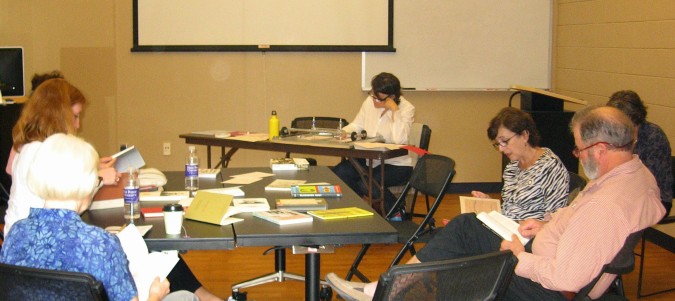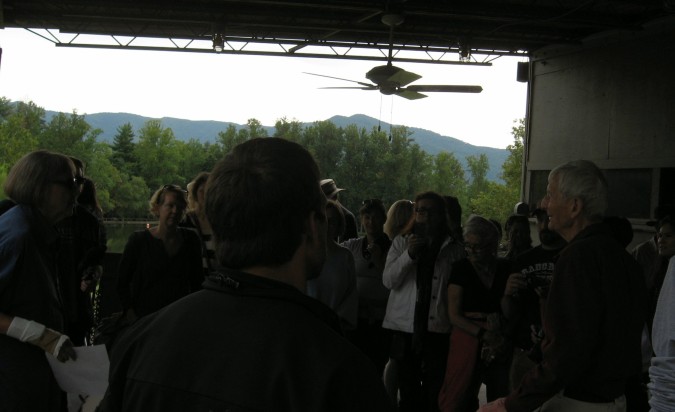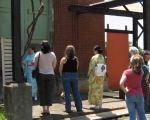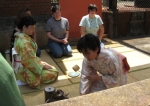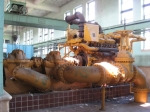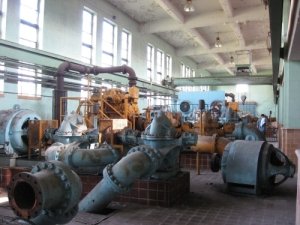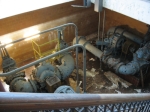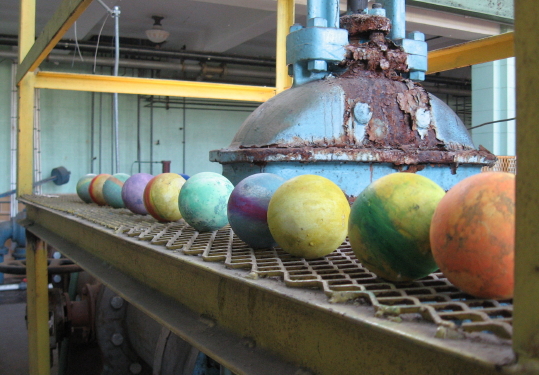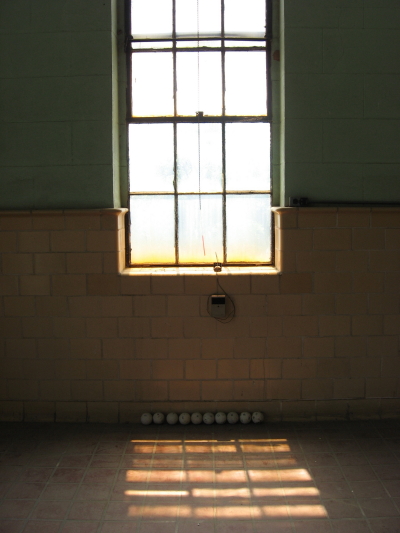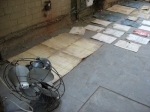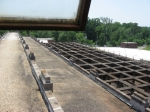At BMC Conference, Performances and Activities Rival Academics
Late September 2014 brought the 6th edition of Re Viewing: Black Mountain College, and my experience, as always, was to be re-invigorated with the vast lessons to be learned from attention to the process and people who inhabited that magical place between 1933 and 1957. This year’s conference had writing as its theme, but the over-all thrust of the events took us well beyond the Olson era at the end of the college’s life, which is usually the focus of BMC literary topics.
The conference is sponsored by the Black Mountain College Museum and Art Center, whose reception for an art show of Dan Rice’s work is seen above. The BMCMAC is growing fast, with a growing permanent collection of BMC art and a newly announced expansion in downtown Asheville. Their conference has been held past two years at UNC-A’s Reuter Center, a lifelong learning institute which serves as a slightly cramped but otherwise excellent venue. It was well attended by presenters from across the country, with a small international contingent as well. A special feature of the conference is the appearance of individuals directly connected to the college, and this year’s prize was Ted Dreier, Jr, who spent his childhood there as his father Ted Sr. played a major role in college life and the business/finances of BMC. Ted Jr. shared many stories during the Sunday campus tour. It was also a great pleasure to meet the grandson of John Dewey, whose educational philosophy was a foundation of BMC.
The simultaneous events always means selection and rejection (or sneaking out and listening a bit). I started with electing for a writing workshop with Jeff Davis, who helped inspire the cut-up project pictured at the top of this post. Jeff had us participants write two words on a deck of 52 cards he provided. Then we dealt ten out and built poems with the selection using a couple of different procedures. We were emulating the “procedural writing” process used by BMC alumnus Jonathan Williams in writing his poem “Mahler: for Symphony No. 7 in B Minor.” It was fun and Jeff offered enthusiastic appreciation for the ironies and amusing juxtapositions in the poems as we shared them. Jonathan’s press, Jargon Society, is now under the auspices of the BMCMAC.
The next session also drew me to a decidedly non-academic presentation, where Ted Pope offered his unique brand of performance poetry. After a mesmerizing rendition of intricate classical guitar by his son, Ted set the tone for his own work by whipping his arrangement of antlers on a tree stump. This was followed by several energetic rants, including one that gave BMCMAC vice-chairman J. Richard Gruber “a whole new perspective on my home state of Kentucky.” Ted’s anarchic approach brings to life some of the spirit of the college, but also evokes a rich sense of the mountain man, wily and cultured in his own way, and helps define the sense of place that was a thread throughout the conference.
Mary Emma Harris, preeminent BMC researcher, and Vincent Katz, keynote speaker, focused on the growing international recognition of the importance and value of Black Mountain College studies and the profound model of experiential and self-directed education its history represents. The editors of the upcoming Anthology of Black Mountain College Poetry discussed their criteria, reflecting the strong literary importance of Olson and the Black Mountain poets as well as the diverse examples of good writing that permeated the entire span of the college’s existence. Ray Johnson, my default interest at all conferences, is included in the anthology, and his writing is also featured in two newly published books: a new printing of Paper Snake and Not Nothing: Selected Writings, 1954-1994, both from Siglio Press. I honestly did not attend enough hard core lectures to report on the literary ideas at the conference, but instead continued my trend of taking in the active and participatory opportunities. They continued to be very rewarding.
When I walked into “Notes for Time and Place, an Improvisational Drawing Performance,” I not only did not know what to expect, I did not recognize the mechanism sitting on the presenter’s table. I might have, because I had seen a much earlier version. Mercedes Teixido has arranged the construction of a Jeffersonian copy machine, built in consultation with the curators of Monticello, and she uses this marvelous machine in her art endeavors. We were given written instructions (in duplicate copies), to peruse the Black Mountain College titles spread out on the table, and to read a passage aloud when the impulse struck us. The written “rules” stated that if we read a passage, she would make a drawing, and we could have one. As a group, we took a little warming up but eventually all of the audience read something aloud, and just as with Jeff Davis’s “Chance of Magic” workshop, there were fun juxtapositions with and reactions to the readings.
Mercedes herself just listened and worked quietly. She patiently placed twin sheets of paper into her marvelous machine after each drawing, and after some time she spread out the twin line drawings for display. We were invited to take one of a pair, leaving her with a documentary set. It was a truly unique experience, and we all bonded a bit through listening to each other read. It was one of the best acts of artistic community-building I have ever seen, and highly appropriate to this conference about a college where art and life, the interior mind and the artistic act, were irrevocably entertwined.
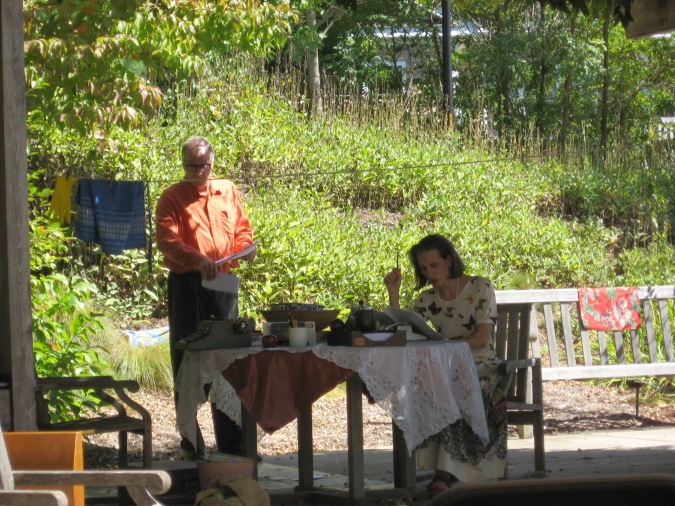
Monika Gross & David Novak stage a reading of selections from the correspondence of Robert Duncan and Denise Levertov
The culmination of my conference experiences came with Re Weaving, a theatrical reading of letters between Robert Duncan and Denise Levertov. Monika’s work attempts to expand our perspective on theater through unusual spaces, modes, or interactions between actors and audience. This performance drew on the powerful phrases of the original exchanges between Duncan and Levertov, but also enacted the spirit of BMC itself with its fresh approach and innovative techniques. The selection, repetition and rhythm of the words built an amazing dynamic between two very powerful and convincing characters ensconced in a stripped down, yet utterly convincing physical set.
This was another performance offered as an alternative to the academic presentations, this one outside on a patio of the Reuter Center, with the readers/actors under a rustic wooden trellis filled with vines. A few simple props (most magnificently exemplified by a manual typewriter) served to evoke the personal spaces of two people who send their thoughts and feelings across the continent. At times, they react in real time to each other’s missives, at times the rapid exchanges represent an argument: there were no limiting rules in the creation of this dialogue. The power of the characters seems enhanced when they take their inner thoughts outside of the defined theatrical space: when David Novak stalks the character of Robert Duncan up the landscaped slope outside the trellis, it is as if he has left the theatrical space but taken us with him, witness to his silent but fully projected thoughts. Monika, who also stepped away as seen above, did her own magic with space, joining the audience and thrusting her hand up like a precocious schoolgirl at the famous Mr. Duncan, asking him the questions that beleaguered this passionate but probably unconsummated intellectual couple. It was a strong, effective and moving performance, honoring and exploring the range of artistic modes that characterize Black Mountain College.
But wait! Hang in there for the BMC campus and farm tour!
For me, the best was last this year. I finally took the Sunday tour, mainly because David Silver had asked me to read for his farm tour and I was thrilled to contribute, in a way however small, to this wonderful event. Mary Emma Harris started us with a tour of the original resort bought by Black Mountain College in 1941. Midway through her exposition of the dining hall and its central role in college life, Ted Dreier, Jr and his wife arrived, and Ms. Harris (as did David Silver later) graciously conceded the speaking stick to this true alumnus of BMC college life, as faculty kid and later as student. He shared wonderful memories about being allowed to sit at meals with students, about the tragedy of his brother’s accidental death and the memorial construction of the Quiet House, and the communal exchange of the bulletin board in the student-constructed Study Hall.
The property purchased by the college is now divided: Camp Rockmount continues to host hundreds of boys each summer, but the upper reaches, including several original cabins and the farm area, still belong to the family who purchased the land from BMC in 1947. The son-in-law of that family, Leigh Maher, is on the BMCMAC board, and joined us for the tour of his part of property.
David Silver followed up his amazing multimedia event at the Hunt Library with a bang-up tour of the farm. He had several people read relevant passages as we stood in front of the barn and silo. Silver’s numerous presentations have made it clear that the the farm was central to the life and very existence of the college, and that its abandonment in the final years not only left the students hungry enough to eat frog legs, but signaled the coming doom of the end. And yet, as Mary Emma Harris said, the real point is that it lasted as long as it did on such precarious financial ground, and lasted long enough to generate waves of students and ideas that permeate American art culture to this day.
Bain Project – Day 1 Photos
The Bain Project opened on Saturday, May 9, to large crowds and great success. The traditional tea presented by Triangle Chanoyu was well attended and ably interpreted by a narrator. Inside, visitors were asked to fill out an entry permit which assigned them to one of the city watersheds. They were then free to explore unguided throughout the structure. I will write more about my experiences when the dust settles, but for now, here is a selection of photos. Each will click to enlarge, while hovering gives you the title.
Jen Coon’s description of tea installation
Several participants from the crowd were invited to take part in the tea. The device used for the purification came from the Bain complex. Recessed green doors served as the alcove, where objects and a carefully selected phrase set the tone for the tea.
The show runs through May 17. Go check it out!
Bain Preview Signals Documentary Style
The preview show for The Bain Water Project, which opened at The Morning Times on First Friday, offered some glimpses of what we can hope to see at the full on-site installation in May. The show also displayed a documentary, self-reflective style which is permeating the group’s work overall, I think in an excellent way. From the large scale photo and video displays seen at the music event, to the “open access” range of information available on some of the artist’s websites, this massive accretion of work is not least interesting for the shape of the artistic process itself, made visible in the large display of notes, drafts, and source materials on display upstairs on Hargett Street.
The artists meet most Saturday mornings at the Bain site to collaborate and consult, then spend many more hours creating art work in response to their experiences. For the preview show, they attempted to evoke a sense of the place, including bringing plants from on site, jars with samples of the debris and filter material, as seen above. The stripped masonry and ancient brick walls of the upper Morning Times are an ideal setting for the work.
The range of media and subjects derived from the Bain site remains quite varied, and if I imagine a conventional show of all the finished artworks I have seen, the unifying thread might be hard to describe. Luke Buchanan Miller’s large traditional paintings have a wonderfully loose sense of perspective and give a successful Impressionist view of an industrial space. But it can be difficult to shift gears and then find a totally different response in the layered, heavily sealed and almost subliminal images in the tiles by Marty Baird right next to these paintings. And this show will need to find room for conceptual art, correspondence art, digital graphics, perhaps some kinetic art, and no doubt some performance art before those weekends in May are over. The preview show gives some very encouraging signs that the individual art is also being couched in a group effort to re-present, artistically, the Bain space itself, and to evoke the artistic experiences being undergone by the group. I’m not complaining about the wide diversity of media emerging in the Bain Project. I think it’s all great. Seeing the imagery from so many artistic perspectives is intrinsically interesting. I’m also fascinated to see the project finding ways to exist outside of and between the individual artworks. One favorite part of this show is where you can see a photo, charcoal sketch, and painting of the same scene. You really get a feel for the artistic experience. The catalog pages, technical sheets, and other tatters of beauracracy offer a sense of the human history and the technical complexities of the place.
The Bain Water Treatment Plant represents a massive subject. The Art Deco exterior and lobby, the huge myriad of pipes, valves, pumps and holding tanks, and the stark abandoned and long neglected human workspaces, all comprise a complex portrait of early twentieth century Raleigh. As this group of artists pulsates in rythym, collaborating and privately creating, I look forward to an amazing show in May. And I hope the documentary style of the preview show, which illuminates the process-as-product, is a big part of the final event.
*************
my photo album of the Bain site
Raleigh Rambles Bain page
Bain Water Project home page
Building the Green Triangle
Green is red hot! Green is the factor of choice to apply in so many settings. You can choose a green college, a green vehicle, and a green refrigerator. I recently learned that right here in the Triangle you can even hire a green caterer. The friendly wager between Ed Begley, Jr. and Bill Nye, as to who has the greenest domicile, made national news. And of course there is a strong local thread of green options online these days, including the strong journalist investigations at Raleigh Eco News and the celebrations of sustainability at Green Grounded.
New construction in the Triangle is no exception. Green architecture is really picking up speed, with growing support from a market-driven, PR-supported, and professionally nurtured series of spectacular successes across the Triangle. Architecture has been the pioneer discipline for the business model of green conservation. A recent conference included some of the area’s largest employers exploring the bottom line benefits of “sustainability, broadly defined as meeting present needs without compromising those of future generations.” Green builders are giving architects exciting arenas for enacting this process. And we all benefit when we put some lean grace into our footprint.
The national icon of green institutional architecture is right here in the Triangle. The EPA campus, dedicated in 2002, represents a standard of both practical details and aesthetic and human values that will be hard to match for a long time. In terms of sustainable design, it is considered the top rated project in the country. Not to be outdone, IBM is building a new data-base center that will be mighty green as well. Durham boasts the North Regional Library and a brand new Duke student residence as highly rated green structures.
Chapel Hill simply requires ALL new construction by or for the town to be LEED certified, which is the national standard of sustainable design. Frank Harmon’s design for the visitor center at the NC Botanical Garden is “slated to be the first Platinum LEED building in the Southeast.”
Frank Harmon seems to be riding a surfer’s wave of green projects. He is working on a multi-phase project at the Museum of Natural Sciences’ Prairie Ridge site in Raleigh, and was recently awarded the design for the new AIA headquarters at the edge of the Blount Streets Commons project.
All of these institutional projects are to be applauded. High end housing, if Ed and Bill have anything to say about it, will continue to grow the value of sustainable design. Local lower income residences may soon be included in the trend. We’ve had a local model for all this a very long time. A good final touch in any discussion of local green architecture is the NCSU Solar House, which, since 1981, has stood as a testament to and lab for these inevitable but so-long delayed trends. Now the Solar House has expanded its mission to support investigations into landfill gas energy, coastal wind programs and Healthybuilt Homes. NCSU and the College of Design give Raleigh and the Triangle a big boost in green leadership – let’s all join in and keep it up!
The park with museum included picks up steam.
Lowe’s Park Pavilion, 2007
Mike Cindric and Vincent Petrarca
Steel, wood, and aluminum
Designed and built specifically for this site overlooking the Piedmont prairie meadow at the NC Museum of Art, Lowe’s Pavilion is “art-as-shelter.” Mike Cindric, as model builder and general technical guru, has been behind the scenes with a host of interesting projects over the years, and I’m thrilled to see him get such a prominent placement for his work, though I’m still mourning the removal of the Patrick Dougherty twig and branch castle recently removed from nearly this same spot. Lowe’s Pavilion has earned a merit award from the NC AIA, and a Sir Walter Raleigh award as well. The metal skin of this outdoor classroom or meditation space changes with the available light, helping to integrate the inhabitants into the natural spaces around the highly sublimated structure.
Mike has created a unique feel inside that highlights the experience of surveying the wonderful sculpture garden, heirloom prairie garden, and wooded hillside trails that have taken shape on the huge campus of the museum. These amenities are the long fruition of one of the few positive trade-offs in the museum’s decision to leave downtown. A few more outdoor images are below.
This place is well worth visit aside from the museum, whose new exhibition space is shown in progress below. The liason with the Raleigh greenway system is also a strong piece of the project. If you haven’t made it yet to the bridge over the Beltline, do it soon! And stop by Lowe’s Pavilion to catch your breath!





